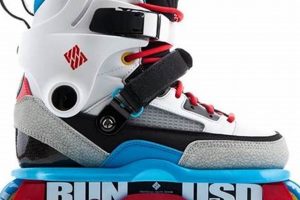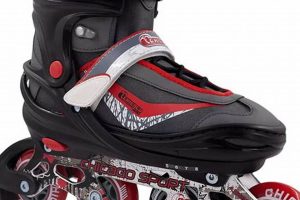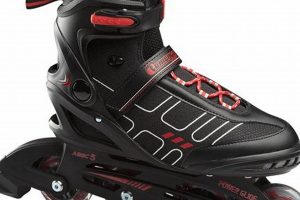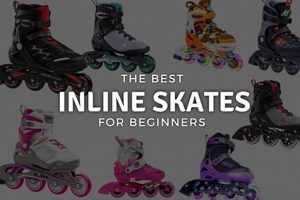Specialized wheeled boots, engineered for performing stunts and tricks, are the central equipment for this action sport. These boots feature a hard shell, supportive liner, and small, hard wheels, facilitating grinds on rails, ledges, and other surfaces. They typically incorporate a “H-block” or similar groove between the middle wheels, optimizing their use for sliding maneuvers.
This discipline offers participants a creative outlet, promoting physical fitness and mental focus. Its origins trace back to the late 1980s and early 1990s, evolving from recreational rollerblading to a distinct and codified extreme sport with its own culture and competitions. The design of the equipment has continuously advanced to meet the demands of increasingly complex maneuvers.
The following discussion will delve into specific aspects of this equipment, including boot construction, wheel characteristics, frame design, and protective gear considerations. Furthermore, variations in riding styles and the locations where the sport is practiced will be examined.
Equipment Maintenance and Skill Development
Proficiency in this dynamic activity necessitates a dual focus: diligent equipment upkeep and systematic skill progression. Neglecting either aspect can impede performance and increase the risk of injury.
Tip 1: Wheel Rotation: Regularly rotate wheels to ensure even wear. This practice extends wheel lifespan and maintains consistent rolling performance, particularly crucial for maintaining speed and control during grinds and transitions.
Tip 2: Bearing Maintenance: Clean and lubricate bearings periodically. Debris accumulation within bearings reduces rolling efficiency. Disassembly, cleaning with solvent, and re-lubrication with appropriate bearing oil are recommended procedures.
Tip 3: Frame Inspection: Routinely inspect frames for cracks or damage. The frame is a critical structural component; compromised integrity can lead to catastrophic failure during high-impact maneuvers. Replacement is necessary if damage is detected.
Tip 4: Protective Gear Adherence: Consistent utilization of helmets, wrist guards, elbow pads, and knee pads is paramount. Injuries are inherent in this discipline, and protective gear significantly mitigates the severity of potential trauma.
Tip 5: Gradual Skill Progression: Avoid attempting advanced tricks before mastering fundamental skills. A solid foundation in basic maneuvers, such as forward skating, backward skating, and basic grinds, is essential for safe and effective advancement.
Tip 6: Video Analysis: Record and analyze riding sessions. Visual feedback allows for identification of technical flaws and facilitates targeted improvement. Comparison with professional riders’ techniques can further refine performance.
Tip 7: Skatepark Etiquette: Adhere to skatepark rules and demonstrate respect for other users. Maintaining a safe and cooperative environment is vital for the collective enjoyment and well-being of all participants.
Proper maintenance safeguards equipment integrity, while disciplined training fosters progressive skill development. This combination contributes to a safer and more rewarding experience in this challenging sport.
The subsequent sections will address specific equipment modifications and advanced techniques for further enhancing performance.
1. Durability
The capacity to withstand sustained stress and impact is paramount in aggressive inline skates. The inherent nature of the activity, involving repeated grinding on abrasive surfaces, aerial maneuvers, and forceful landings, places extreme demands on the equipment. Insufficient durability precipitates premature equipment failure, elevating the risk of injury and incurring significant replacement costs.
Consider the repeated stress on the boot’s shell during a series of grinds on a concrete ledge. A shell constructed from low-grade plastic will quickly degrade, developing cracks and compromising structural integrity. This, in turn, can lead to ankle instability and potential fractures. Conversely, a boot employing a high-density composite material will resist abrasion and maintain its form, thereby enhancing safety and prolonging its lifespan. The frame, similarly, experiences high stress during landings from elevated surfaces. A frame forged from inferior aluminum alloys is susceptible to bending or breaking, resulting in loss of control and potential injury. Frames constructed from aircraft-grade aluminum or reinforced polymers offer superior resistance to deformation and failure, thus mitigating these risks. Wheels also demand to be durable. The material used has to withstand the concrete terrain that this kind of skating is involved with.
Therefore, durability is not merely a desirable attribute, but a fundamental requirement for aggressive inline skates. The selection of materials, manufacturing processes, and overall design must prioritize resistance to wear, impact, and fatigue to ensure both the longevity of the equipment and the safety of the user. Understanding this necessity is crucial for both manufacturers seeking to produce reliable products and consumers aiming to make informed purchasing decisions. Skates without durability will fall short on their purpose and will be used at a faster rate, becoming a financial liability in the long run.
2. Maneuverability
Maneuverability, in the context of aggressive inline skates, refers to the equipment’s capacity to respond swiftly and accurately to rider inputs. This attribute is crucial for executing complex tricks, navigating obstacles, and maintaining control during high-impact maneuvers. The design elements contributing to maneuverability directly impact the skater’s ability to perform safely and effectively.
- Frame Geometry and Wheelbase
A shorter wheelbase generally enhances maneuverability, allowing for quicker turns and rotations. Frame geometry, including the angle and placement of wheels, influences the skate’s responsiveness. For example, a frame with a centered wheel position facilitates balanced landings and smooth transitions between grinds. An elongated frame, conversely, may provide increased stability at high speeds, but at the cost of agility. The skater’s intended riding style should dictate frame selection.
- Wheel Durometer and Profile
Wheel durometer, measured on the A scale, determines the hardness of the wheel. Softer wheels (lower durometer) offer greater grip and shock absorption, improving control on rough surfaces. Harder wheels (higher durometer) provide faster rolling speed and increased durability for grinds. The wheel profile, whether rounded or flat, also influences maneuverability. Rounded profiles facilitate smoother turns and transitions, while flat profiles offer greater stability during grinds. The choice depends on riding preferences and terrain.
- Boot Stiffness and Responsiveness
The stiffness of the boot directly affects the transfer of energy from the skater’s foot to the frame and wheels. A stiffer boot provides greater responsiveness and control, allowing for precise movements and powerful landings. However, overly stiff boots can restrict ankle flexibility, potentially hindering certain tricks. Conversely, a more flexible boot offers increased comfort and freedom of movement, but may compromise control and stability, particularly at high speeds. Optimal boot stiffness balances support and flexibility.
- Bearing Precision and Spacing
High-precision bearings minimize friction and maximize rolling speed, contributing to overall maneuverability. The ABEC rating system quantifies bearing precision, with higher ratings indicating tighter tolerances and smoother rolling. Bearing spacers maintain consistent wheel alignment, reducing friction and enhancing stability. Properly maintained and lubricated bearings are essential for optimal performance and responsiveness.
The interplay of frame geometry, wheel characteristics, boot stiffness, and bearing precision collectively determines the maneuverability of aggressive inline skates. Selecting equipment that aligns with individual riding style and skill level is crucial for maximizing performance and minimizing the risk of injury. Furthermore, consistent maintenance and proper technique are essential for unlocking the full potential of the equipment.
3. Grind Surfaces
Interaction with various surfaces defines a significant aspect of aggressive inline skating. The characteristics of these surfaces dictate the execution of tricks and the lifespan of the equipment. Understanding this relationship is essential for both skaters and equipment manufacturers.
- Surface Material and Friction
Different materials offer varying degrees of friction. Waxed concrete, metal rails, and plastic ledges are common surfaces encountered. Lower friction allows for smoother, faster grinds, but may reduce control. Higher friction provides greater control but can increase wear on skates. The skater must adapt technique based on the specific surface.
- Surface Texture and Condition
The texture of a surface affects grind execution. Smooth surfaces facilitate consistent slides, while rough surfaces introduce unpredictable resistance. The presence of cracks, debris, or imperfections can disrupt the grind and increase the risk of injury. Consistent inspection and maintenance of grind surfaces are important for safety.
- Edge Profile and Coping
The edge profile of a grind surface, such as a rail or ledge, significantly impacts the type of tricks that can be performed. Rounded edges are more forgiving but offer less lock-in, while sharp edges provide greater stability but require more precise technique. Coping, the metal edge found on skatepark ramps, is specifically designed for grinding and offers a consistent and durable surface.
- Environmental Factors
Environmental factors, such as temperature and moisture, can influence surface characteristics. Extreme heat can soften certain materials, reducing friction and increasing wear. Moisture can increase friction and create hazardous conditions. Awareness of these factors is crucial for maintaining control and preventing accidents.
The selection of appropriate grind surfaces and adaptation of technique are integral components of aggressive inline skating. Recognizing the interplay between surface material, texture, edge profile, and environmental factors allows skaters to optimize performance and minimize risk. Equipment design, particularly the H-block and frame, is directly influenced by the types of surfaces encountered.
4. Wheel Configuration
Wheel configuration constitutes a pivotal design element in aggressive inline skates, directly influencing the skater’s ability to perform grinds, aerial maneuvers, and maintain stability. Unlike recreational skates, aggressive models often employ specific wheel setups tailored for the demands of trick-based skating. This configuration deviates from a simple inline arrangement to accommodate the unique requirements of the sport, prioritizing grindability and control over pure speed.
One common configuration features smaller, harder wheels flanking a central grind block, or “H-block,” recessed between the middle wheels. The reduced wheel diameter lowers the center of gravity, enhancing stability during landings and providing clearance for grinding on rails and ledges. The H-block, typically made of durable plastic, facilitates smooth sliding along these surfaces. An alternative configuration involves anti-rocker wheels, which are small, hard wheels positioned in the middle two slots, effectively acting as spacers to prevent wheel bite during grinds and further enhancing H-block functionality. The choice of configuration profoundly impacts the skater’s ability to execute specific tricks and navigate different terrain types within skate parks or urban environments.
Understanding the interplay between wheel configuration and performance is crucial for selecting appropriate skates and optimizing skating technique. The configuration must align with the skater’s preferred style, whether emphasizing technical grinds, aerial tricks, or a combination of both. Incorrect configuration choices can hinder progress, increase the risk of injury, and limit the skater’s overall potential. Thus, careful consideration of wheel size, hardness, and placement is paramount when choosing aggressive inline skates.
5. Impact Resistance
Aggressive inline skates are subjected to extreme forces during the execution of tricks and maneuvers. The capacity to withstand these forces, termed impact resistance, is a critical attribute directly affecting skater safety and equipment longevity. The repeated shocks from jumps, landings, and collisions with obstacles necessitate robust construction and materials engineered to absorb and dissipate energy effectively. Failure to provide adequate impact resistance results in equipment failure, ranging from minor component damage to catastrophic structural collapse, potentially leading to severe injuries. Skaters frequently endure impacts equivalent to several times their body weight, highlighting the importance of this design parameter.
The materials used in the boot shell, frame, and wheels significantly influence impact resistance. High-density plastics, reinforced composites, and aircraft-grade aluminum alloys are common choices for boot and frame construction, offering a balance of strength, weight, and energy absorption. Wheel durometer (hardness) also plays a role, with softer wheels generally providing greater impact absorption but sacrificing rolling speed and durability for grinding. The design of the skate itself contributes to impact resistance. Features such as shock-absorbing footbeds, reinforced ankle supports, and strategically placed padding further mitigate the effects of impacts. For example, a skate lacking sufficient ankle support may be prone to sprains or fractures during hard landings. The choice of protective gear, including helmets, wrist guards, elbow pads, and knee pads, complements the impact resistance of the skates, providing an additional layer of protection against injury.
In summary, impact resistance is an indispensable characteristic of aggressive inline skates, ensuring both the safety of the skater and the durability of the equipment. Material selection, structural design, and the integration of protective features are all critical factors. Neglecting impact resistance compromises the skater’s well-being and diminishes the lifespan of the skates. A comprehensive understanding of these aspects is crucial for manufacturers, retailers, and skaters alike to make informed decisions regarding equipment selection and usage. Its important to remember the sport of aggressive inline skating is fun but safety is a priority.
6. Ankle support
Ankle support is a critical element in aggressive inline skate design, directly influencing rider stability, control, and injury prevention. The aggressive nature of the sport, involving high-impact landings and rapid directional changes, places substantial stress on the ankle joint. Insufficient support can lead to sprains, fractures, or chronic instability, hindering performance and potentially causing long-term damage. The construction of the skate boot is therefore paramount in providing the necessary structural reinforcement.
Boots designed for aggressive inline skating typically feature a high-cut cuff, extending well above the ankle joint. This cuff is often reinforced with rigid materials, such as high-density plastics or composite materials, to restrict excessive lateral or medial movement. The rigidity of the cuff directly correlates with the level of support provided, but must be balanced with the need for some degree of ankle flexion to facilitate specific maneuvers. Lacing systems, power straps, and buckles work in conjunction with the cuff to secure the foot and ankle within the boot, further enhancing stability. For instance, a skater attempting a gap jump without adequate ankle support is at significantly increased risk of rolling an ankle upon landing, potentially resulting in a debilitating injury. The design should allow users to feel comfortable and confident.
Ultimately, ankle support in aggressive inline skates represents a crucial trade-off between stability and mobility. Optimal designs prioritize protecting the ankle joint from injury while still allowing for the range of motion necessary to execute advanced tricks. Skaters must carefully evaluate the level of support offered by different skate models, considering their individual needs, skill level, and risk tolerance. A well-supported ankle is foundational to both performance and safety in this demanding sport.
7. Frame material
The frame material of aggressive inline skates is a pivotal determinant of performance, durability, and overall skater experience. The frame serves as the critical link between the boot, wheels, and grind surfaces, bearing the brunt of impact forces and torsional stresses generated during aggressive maneuvers. The properties of the chosen material directly influence the skate’s responsiveness, stability, and resistance to damage.
- Aluminum Alloys
Aluminum alloys are a prevalent choice for aggressive skate frames, offering a favorable strength-to-weight ratio. Different alloys, such as 6061 and 7005 series aluminum, provide varying degrees of stiffness and impact resistance. Frames constructed from these alloys generally offer precise control and efficient energy transfer, enhancing responsiveness during grinds and aerial tricks. However, aluminum frames may be susceptible to bending or cracking under extreme stress, particularly at weld points, necessitating careful design and manufacturing processes. For example, a frame used in repeated rail grinds may experience fatigue over time, potentially leading to structural failure.
- Composite Materials
Composite materials, such as fiberglass-reinforced nylon or carbon fiber, offer an alternative to aluminum alloys, providing a unique combination of properties. These materials can be engineered to provide specific flex characteristics, enhancing shock absorption and improving comfort. Composite frames are generally lighter than aluminum frames, potentially reducing skater fatigue during extended sessions. However, composite materials may be more susceptible to abrasion and impact damage than aluminum alloys, requiring protective features such as replaceable grind plates. A skater performing frequent ledge grinds may find that a composite frame wears down more quickly than an aluminum frame.
- Steel
Steel, although less common than aluminum or composites, offers exceptional durability and resistance to bending. Steel frames are often used in specialized applications where maximum strength is paramount, such as skates designed for aggressive street skating. Steel frames are typically heavier than aluminum or composite frames, potentially reducing agility and increasing skater fatigue. However, the increased weight can also contribute to stability during high-speed grinds. A steel frame may be preferred by skaters who prioritize durability over weight and maneuverability.
- Frame Design and Construction Methods
Beyond the base material, the design and construction methods employed significantly impact frame performance. Extruded frames offer precise shapes and consistent material properties, while welded frames allow for more complex designs and reinforcement in high-stress areas. Heat treatment processes can further enhance the strength and durability of aluminum frames. The integration of features such as replaceable grind blocks, adjustable wheelbases, and UFS (Universal Frame System) mounting points adds versatility and customization options. A well-designed frame, regardless of the material, will optimize weight distribution, enhance stability, and improve the overall skating experience.
The selection of frame material for aggressive inline skates involves a complex interplay of factors, including strength, weight, durability, and desired performance characteristics. Aluminum alloys offer a balance of responsiveness and durability, composite materials provide enhanced shock absorption and lightweight performance, and steel delivers maximum strength and resistance to bending. The optimal choice depends on the skater’s individual preferences, riding style, and the specific demands of the intended terrain. Careful consideration of these factors is essential for maximizing performance and ensuring skater safety.
Frequently Asked Questions
This section addresses common inquiries regarding aggressive inline skates, providing factual information to aid in understanding their design, usage, and maintenance.
Question 1: What distinguishes aggressive inline skates from recreational inline skates?
Aggressive inline skates are engineered for performing stunts and tricks, featuring robust construction, smaller wheels, and a grind block or H-block. Recreational inline skates prioritize speed and comfort for distance skating, with larger wheels and softer boots.
Question 2: What safety equipment is essential for aggressive inline skating?
Helmets, wrist guards, elbow pads, and knee pads are considered mandatory safety equipment. Mouthguards and padded shorts are also recommended for advanced skaters attempting more complex tricks.
Question 3: How should aggressive inline skates be properly maintained?
Regular maintenance includes wheel rotation to ensure even wear, bearing cleaning and lubrication to maintain rolling efficiency, and frame inspection for cracks or damage. Prompt replacement of worn or damaged parts is crucial.
Question 4: What factors should be considered when selecting aggressive inline skates?
Factors to consider include boot fit and support, frame material and design, wheel size and durometer, grind block configuration, and overall durability. Matching the equipment to the intended riding style and skill level is essential.
Question 5: What is the lifespan of aggressive inline skate wheels?
Wheel lifespan varies depending on usage, surface conditions, and wheel durometer. Softer wheels wear down more quickly than harder wheels. Regular rotation and proper technique can extend wheel lifespan.
Question 6: Can aggressive inline skates be used for recreational skating?
While possible, aggressive inline skates are not ideally suited for recreational skating. Their smaller wheels and stiffer boots are less efficient for distance skating and may cause discomfort over extended periods.
This FAQ provides a concise overview of essential information regarding aggressive inline skates. Further research and consultation with experienced skaters are recommended for more in-depth knowledge.
The following article sections will delve into specific aspects of aggressive inline skating techniques and training methodologies.
Aggressive Inline Skates
This exploration has considered the multifaceted nature of aggressive inline skates. From examining material properties impacting durability and maneuverability to analyzing the influence of wheel configuration and frame design, a comprehensive understanding has been established. The critical role of ankle support and impact resistance has been emphasized, underscoring the inherent risks and requisite safety measures associated with the sport.
The ongoing evolution of equipment design and materials science promises continued advancements in aggressive inline skates. Continued research and development focused on enhancing safety, optimizing performance, and extending equipment lifespan will further contribute to the sport’s growth and accessibility. Prudent equipment selection, diligent maintenance, and a commitment to skill development remain paramount for all practitioners.




![Best Chicago Skates Inline Skates: [Year] Guide & More! Safem Fabrication - Precision Engineering & Custom Manufacturing Solutions Best Chicago Skates Inline Skates: [Year] Guide & More! | Safem Fabrication - Precision Engineering & Custom Manufacturing Solutions](https://cruzskateshop.com/wp-content/uploads/2025/06/th-3478-300x200.jpg)


